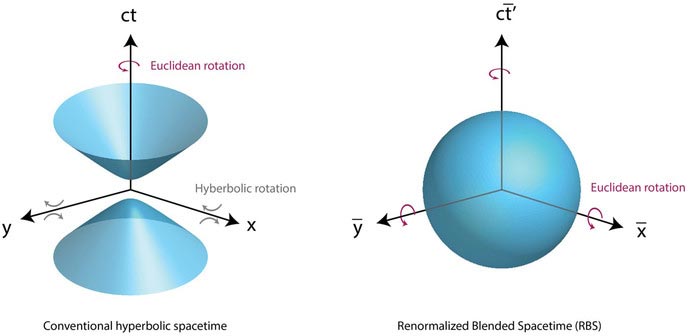A Penn State scientist studying crystal structures has developed a new mathematical formula that could solve a decades-old problem in understanding space-time, the fabric of the universe proposed in Einstein’s theories of relativity .
“Relativity tells us that space and time can blend together to form a single entity called space-time, which is four-dimensional: three spatial axes and one time axis,†said Venkatraman Gopalan, professor of science and technology. engineering and materials engineering at Penn State. “However, something on the time axis sticks out like a sore thumb.”
For calculations to work under relativity, scientists need to put a negative sign on time values ​​that they don’t have to place on space values. Physicists have learned to work with negative values, but this means that spacetime cannot be dealt with using traditional Euclidean geometry and must instead be viewed with the more complex hyperbolic geometry.
Gopalan has developed a two-step mathematical approach that blurs the differences between space and time, removing the negative sign problem and serving as a bridge between the two geometries.

A diagram showing the process of creating a “renormalized mixed space-time”. Penn State scientist Venkatraman Gopalan studies crystal structures and has developed a new mathematical formula that could solve a decades-old problem in understanding space-time, the fabric of the universe proposed in theories of Einstein’s relativity. Credit: Hari Padmanabhan, State of Pennsylvania
“For over 100 years there has been an effort to equate space and time,†said Gopalan. “But that really didn’t happen because of that minus sign. This research removes that problem at least in special relativity. Space and time are really on the same footing in this work. The article, published on May 27, 2021, in the review Acta Crystallographica A, is accompanied by a commentary in which two physicists write that Gopalan’s approach may hold the key to unifying quantum mechanics and gravity, two fundamental areas of physics that have yet to be fully unified.
“Gopalan’s idea of ​​general relativistic space-time crystals and how to obtain them is both powerful and broad,†said Martin Bojowald, professor of physics at Penn State. “This research, in part, presents a new approach to a physics problem that has not been solved for decades.”
In addition to providing a new approach to relate space-time to traditional geometry, the research has implications for the development of new structures with exotic properties, known as space-time crystals.
Crystals contain repeated arrangements of atoms, and in recent years scientists have explored the concept of temporal crystals, in which the state of a material changes and is also repeated over time, like a dance. However, time is disconnected from space in these formulations. The method developed by Gopalan would allow the exploration of a new class of space-time crystals, where space and time can mix.
“These possibilities could pave the way for a whole new class of metamaterials with exotic properties otherwise unavailable in nature, in addition to understanding the fundamental attributes of a number of dynamic systems,” said Avadh Saxena, a physicist at the National Laboratory. from Los Alamos.
Gopalan’s method consists of mixing two separate observations of the same event. Mixing occurs when two observers exchange temporal coordinates but keep their own spatial coordinates. With an additional mathematical step called renormalization, this leads to a “renormalized mixed space-time”.
“Let’s say I’m on the ground and you’re flying on the space station, and we both observe an event like a comet hovering over,†Gopalan said. “You take your measurement of when and where you saw it, and I take mine of the same event, and then we compare the notes. I then adopt your measure of time as mine, but I keep my original spatial measure of the comet. You in turn adopt my measure of time as yours, but keep your own measure of the comet’s space. From a mathematical standpoint, if we do this mixing of our measurements, the boring minus sign disappears.
The references:
“Relativistic space-time crystals” by V. Gopalan, May 27, Acta Crystallographica A.
DOI: 10.1107 / S2053273321003259
“From crystal color symmetry to quantum spacetime†by M. Bojowald and A. Saxena, May 27, Acta Crystallographica A.
DOI: 10.1107 / S2053273321005234
The National Science Foundation funded this research.
 Universo Viviente
Universo Viviente



